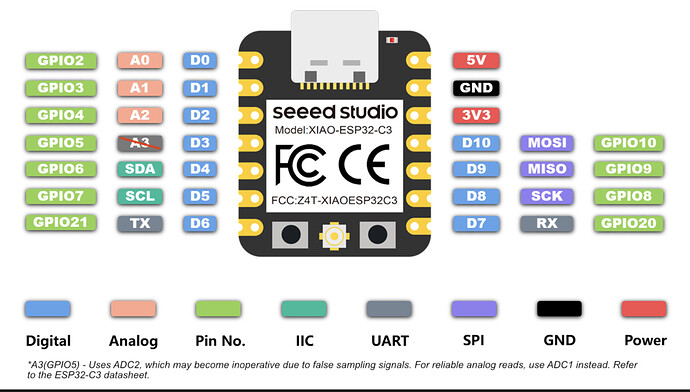cgwaltney:
U8G2
This is the driver code?
/* display and touch driver for XIAO round screen */
#include <Arduino.h>
#include <lvgl.h>
#include <SPI.h>
#include <Wire.h>
#define SCREEN_WIDTH 240
#define SCREEN_HEIGHT 240
#define LVGL_BUFF_SIZE 10 // Number of rows
#define CHSC6X_I2C_ID 0x2e
#define CHSC6X_MAX_POINTS_NUM 1
#define CHSC6X_READ_POINT_LEN 5
#define TOUCH_INT D7
#ifndef XIAO_BL
#define XIAO_BL D6
#endif
#define XIAO_DC D3
#define XIAO_CS D1
uint8_t screen_rotation;
/* display driver : use TFT_eSPI or Arduino_GFX */
#if defined(USE_TFT_ESPI_LIBRARY) && defined(USE_ARDUINO_GFX_LIBRARY)
#error "More than one graphics library is defined."
#elif defined(USE_TFT_ESPI_LIBRARY)
#include <TFT_eSPI.h>
TFT_eSPI tft = TFT_eSPI(SCREEN_WIDTH, SCREEN_HEIGHT);
#elif defined(USE_ARDUINO_GFX_LIBRARY)
#include <Arduino_GFX_Library.h>
#define SPI_FREQ 20000000 // SPI bus frequency: 20Mhz
#if defined(CONFIG_IDF_TARGET_ESP32S3) || defined(CONFIG_IDF_TARGET_ESP32C3)
Arduino_DataBus *bus = new Arduino_ESP32SPI(XIAO_DC, XIAO_CS, SCK, MOSI, MISO, FSPI);
#elif defined(ARDUINO_Seeed_XIAO_nRF52840_Sense) || defined(ARDUINO_Seeed_XIAO_nRF52840)
Arduino_DataBus *bus = new Arduino_NRFXSPI(XIAO_DC, XIAO_CS, SCK, MOSI, MISO);
#elif defined(ARDUINO_SEEED_XIAO_NRF52840_SENSE) || defined(ARDUINO_SEEED_XIAO_NRF52840)
Arduino_DataBus *bus = new Arduino_mbedSPI(XIAO_DC, XIAO_CS);
#elif defined(ARDUINO_SEEED_XIAO_RP2040)
Arduino_DataBus *bus = new Arduino_RPiPicoSPI(XIAO_DC, XIAO_CS, SCK, MOSI, MISO, spi0);
#else
Arduino_DataBus *bus = new Arduino_HWSPI(XIAO_DC, XIAO_CS);
#endif
Arduino_GFX *gfx = new Arduino_GC9A01(bus, -1, screen_rotation, true);
#else
#error "Please define a graphics library for display."
#endif
#if LVGL_VERSION_MAJOR == 9
void xiao_disp_flush( lv_display_t *disp, const lv_area_t *area, uint8_t *px_map )
#elif LVGL_VERSION_MAJOR == 8
void xiao_disp_flush( lv_disp_drv_t *disp, const lv_area_t *area, lv_color_t *color_p )
#else
#error "Not support LVGL version"
#endif
{
uint32_t w = ( area->x2 - area->x1 + 1 );
uint32_t h = ( area->y2 - area->y1 + 1 );
#if LVGL_VERSION_MAJOR == 9
uint16_t *px_buf = ( uint16_t * )px_map;
#elif LVGL_VERSION_MAJOR == 8
uint16_t *px_buf = ( uint16_t * )&color_p->full;
#endif
#if defined(USE_TFT_ESPI_LIBRARY)
tft.startWrite();
tft.setAddrWindow( area->x1, area->y1, w, h );
tft.pushColors( px_buf, w * h, true );
tft.endWrite();
#elif defined(USE_ARDUINO_GFX_LIBRARY)
gfx->draw16bitRGBBitmap(area->x1, area->y1, px_buf, w, h);
#endif
#if LVGL_VERSION_MAJOR == 9
lv_display_flush_ready(disp);
#elif LVGL_VERSION_MAJOR == 8
lv_disp_flush_ready(disp);
#endif
}
void xiao_disp_init(void)
{
#if XIAO_BL > 0
pinMode(XIAO_BL, OUTPUT); //Turn on screen backlight
digitalWrite(XIAO_BL, HIGH);
#endif
#if defined(USE_TFT_ESPI_LIBRARY)
tft.begin();
tft.setRotation( screen_rotation );
tft.fillScreen(TFT_BLACK);
#elif defined(USE_ARDUINO_GFX_LIBRARY)
gfx->begin(SPI_FREQ);
gfx->fillScreen(BLACK);
#endif
}
void lv_xiao_disp_init(void)
{
xiao_disp_init();
#if LVGL_VERSION_MAJOR == 9
static uint8_t draw_buf[ SCREEN_WIDTH * LVGL_BUFF_SIZE * LV_COLOR_DEPTH / 8 ];
lv_display_t * disp = lv_display_create(SCREEN_WIDTH, SCREEN_HEIGHT);
lv_display_set_flush_cb(disp, xiao_disp_flush);
lv_display_set_buffers(disp, (void*)draw_buf, NULL, sizeof(draw_buf), LV_DISPLAY_RENDER_MODE_PARTIAL);
#elif LVGL_VERSION_MAJOR == 8
/*Initialize the display buffer*/
static lv_disp_draw_buf_t draw_buf;
static lv_color_t buf[ SCREEN_WIDTH * LVGL_BUFF_SIZE ];
lv_disp_draw_buf_init( &draw_buf, buf, NULL, SCREEN_WIDTH * LVGL_BUFF_SIZE );
/*Initialize the display driver for lvgl*/
static lv_disp_drv_t disp_drv;
lv_disp_drv_init( &disp_drv );
disp_drv.hor_res = SCREEN_WIDTH;
disp_drv.ver_res = SCREEN_HEIGHT;
disp_drv.flush_cb = xiao_disp_flush;
disp_drv.draw_buf = &draw_buf;
lv_disp_drv_register( &disp_drv );
#endif
}
/* touch driver : chsc6x */
bool chsc6x_is_pressed(void)
{
if(digitalRead(TOUCH_INT) != LOW) {
delay(1);
if(digitalRead(TOUCH_INT) != LOW)
return false;
}
return true;
}
void chsc6x_convert_xy(uint8_t *x, uint8_t *y)
{
uint8_t x_tmp = *x, y_tmp = *y, _end = 0;
for(int i=1; i<=screen_rotation; i++){
x_tmp = *x;
y_tmp = *y;
_end = (i % 2) ? SCREEN_WIDTH : SCREEN_HEIGHT;
*x = y_tmp;
*y = _end - x_tmp;
}
}
void chsc6x_get_xy(lv_coord_t * x, lv_coord_t * y)
{
uint8_t temp[CHSC6X_READ_POINT_LEN] = {0};
uint8_t read_len = Wire.requestFrom(CHSC6X_I2C_ID, CHSC6X_READ_POINT_LEN);
if(read_len == CHSC6X_READ_POINT_LEN){
Wire.readBytes(temp, read_len);
if (temp[0] == 0x01) {
chsc6x_convert_xy(&temp[2], &temp[4]);
*x = temp[2];
*y = temp[4];
}
}
}
#if LVGL_VERSION_MAJOR == 9
void chsc6x_read( lv_indev_t * indev, lv_indev_data_t * data )
#elif LVGL_VERSION_MAJOR == 8
void chsc6x_read( lv_indev_drv_t * indev_driver, lv_indev_data_t * data )
#endif
{
lv_coord_t touchX, touchY;
if( !chsc6x_is_pressed() )
{
data->state = LV_INDEV_STATE_REL;
} else {
data->state = LV_INDEV_STATE_PR;
chsc6x_get_xy(&touchX, &touchY);
/*Set the coordinates*/
data->point.x = touchX;
data->point.y = touchY;
}
}
void lv_xiao_touch_init(void)
{
pinMode(TOUCH_INT, INPUT_PULLUP);
Wire.begin(); // Turn on the IIC bus for touch driver
/*Initialize the touch driver for lvgl*/
#if LVGL_VERSION_MAJOR == 9
lv_indev_t * indev = lv_indev_create();
lv_indev_set_type(indev, LV_INDEV_TYPE_POINTER);
lv_indev_set_read_cb(indev, chsc6x_read);
#elif LVGL_VERSION_MAJOR == 8
static lv_indev_drv_t indev_drv;
lv_indev_drv_init(&indev_drv);
indev_drv.type = LV_INDEV_TYPE_POINTER;
indev_drv.read_cb = chsc6x_read;
lv_indev_drv_register(&indev_drv);
#endif
}
Using digitalwrite to D6 doesn’t appear to do anything? I want to turn the backlight off for example?



